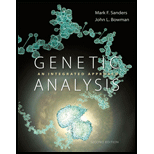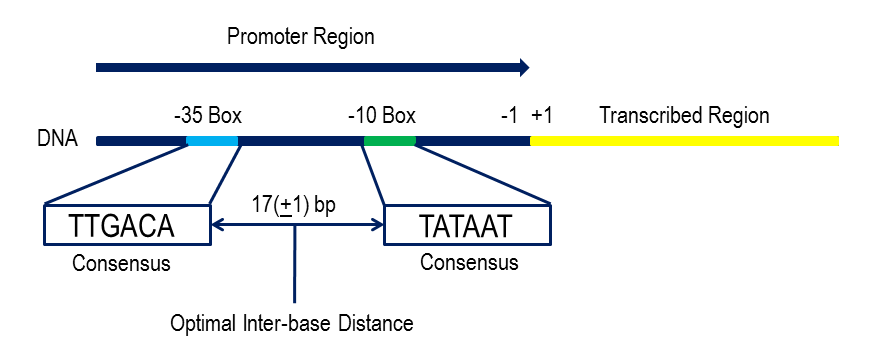
Concept explainers
To analyze:
Table-C contains DNA-sequence information compiled by Marilyn Kozak (

Introduction:
Consensus sequences are a short stretch of DNA sequences that are commonly located nucleotides found at a specific location of DNA and RNA. These sequences are used for inter or intramolecular interactions. These sequences are similar in structure and function in all organisms. The consensus sequence is a calculated order that states the most frequent nucleotide at that position in the alignment.

Want to see the full answer?
Check out a sample textbook solution
Chapter 9 Solutions
Genetic Analysis: An Integrated Approach (2nd Edition)
- The sequence of a polypeptide is determined by the order of codons that specify the amino acids in the polypeptide. How many different sequences of codons can specify the polypeptide sequence methionine-histidine-lysine? (Use the table to find the number of possibilities.) SECOND BASE UAU UACFTyrosine (Tyr) UAA -Stop codon UAG -Stop codon UUUL UGU Cysteine (Cys) UCU uc UCA FSerine (Ser) uca Uuc Phenylalanine (Phe) UUAL Leucine (Leu) CAU CAC CAA Glutamine (Gin) CAGF UGA -Stop codon uaa -Tryptophan (Trp) CGU сос CGA FArginine (Arg) CU CU Histidine (His) CuA FLeucine (Leu) Cua) Proline (Pro) CCA cca AAU Asparagine (Asn) AGU Serine (Ser) AGC AUU ACU ACC Threonine (Thr) AACF AAA AAGLysine (Lys) AUC Fisoleucine (lle) AUA Methionine (Met) AUG - Start codon ACA ACG AGA AGGFArginine (Arg) GU GACAspartic acid (Asp) GGA GAA Glutamic acid (Glu) Gaa) GcU -Valine (Val) G GUA GCA FAlanine (Ala) Glycine (Gly) 8. 1 4 THIRD BASE 2. FIRST BASEarrow_forwardWrite the detail or exact information of the follwoing of molecule “X” with UniProtKB accession number P18564. I. Chromosome number:II. Protein size:III. Number of exons:IV. Stop codon:V. Size of the longest exon in nucleotidesarrow_forwardBelow is a sequence of DNA. 5'-ttaccgataattctctctcccctcttccatgattctgattaaagaaggcgagaacgaaactatttgttaatacc-3' Using the one letter code for Amino Acids, what is the predicted AA sequence of the shortest ORF (from N to C-terminal end)? Using the one letter code for Amino Acids, what is the predicted AA sequence of the longest ORF (from N to C-terminal end)?arrow_forward
- Below is a short nucleotide sequence from a gene. Use the Internet(e.g., see www.ncbi.nlm.nih.gov/Tools) to determine what genethis sequence is from. Also, determine the species in which thisgene sequence is found. 5’–GGGCGCAATTACTTAACGCCTCGATTATCTTCTTGC GCCACTGATCATTA–3’arrow_forwardWe have talked about several examples of cis-acting elements that have dyad symmetry (inverted repeat symmetry). Some function on the level of DNA, and others function on the level of RNA. Give one example of one that functions at the DNA level and briefly explain why the sequence requires dyad symmetry to work properly. Note: you don't have to give an exact sequence, just the name of the element. Edit View Incort Format Tools Tabloarrow_forwardThe consensus sequence of the protospacer adjacent motif (PAM) sequence in bacterial strain A is 5'-NGG-3, whereas in bacterial strain B the consensus PAM sequence is 5'-NGRRN-3: Calculate the frequency at which each of these PAM sequences will occur in DNA using N = any nucleotide and R = purine base. Bacterial strain A: PAM sequence occurs once in every 16 nucleotides Bacterial strain B: PAM sequence occurs once in every 32 nucleotides Bacterial strain A: PAM sequence occurs once in every 32 nucleotides Bacterial strain B: PAM sequence occurs once in every 16 nucleotides Bacterial strain A: PAM sequence occurs once in every 32 nucleotides Bacterial strain B: PAM sequence occurs once in every 32 nucleotides Bacterial strain A: PAM sequence occurs once in every 16 nucleotides Bacterial strain B: PAM sequence occurs once in every 16 nucleotidesarrow_forward
- Representations of sequencing chromatograms for variants of the a chain of human hemoglobin are shown here. Match each of the variants with the corresponding amino acid change. You can use the codon table to decode each amino acid sequence. For example, the first triplet encodes for Val. Normal Chongqing ddATP ddCTP ddGTP ddTTP Pro to Thr Gly to Asp Leu to Arg Karachi Swan River Answer Bank Ala to Pro Asp to Gly Pro to Ala Arg to Leu Asp to Asn Arg to Valarrow_forwardState the properties of the WatsonCrick model of DNA in the following categories: a. number of polynucleotide chains b. polarity (running in same direction or opposite directions) c. bases on interior or exterior of molecule d. sugar/phosphate on interior or exterior of molecule e. which bases pair with which f. right- or left-handed helixarrow_forwardBelow is a sequence of DNA.5'-ttaccgataattctctctcccctcttccatgattctgattaaagaaggcgagaacgaaactatttgttaatacc-3' How many "reading frames" can be identified for this sequence? How many "open reading frames" can be identified for this sequence? What is the frame of the longest ORF? How many codons are in the longest ORF? What is the frame of the shortest ORF? How many AA are in the shortest ORF? Using the one letter code for Amino Acids, what is the predicted AA sequence of the shortestORF (from N to C-terminal end)? Using the one letter code for Amino Acids, what is the predicted AA sequence of the longestORF (from N to C-terminal end)?arrow_forward
- Given the mRNA sequence below, 5'-UUCCCAAAGUAU-3'Answer the following below:1. What is the sequence of amino acids using the table of genetic code? (three-letter abbreviation)2. Given the situation that a mutation occurs by substitution of the 12th nucleotide with cytidine 5'-monophosphate, what is the resulting amino acid sequence?3. What type of mutation occured? Specific what type under frameshift and point mutationsarrow_forwardThe sequence of the coding strand of a bacterial gene is given below. The positions of the first nine bases are numbered for your convenience. A missense mutation was introduced at position seven where the C was changed to a T resulting a mutant gene. 123456789 5'- ATGGCCCGACCGCAACTTTTCCGAGCTCTGGTGTCTGCGCAGTGACC-3 a. Write the template DNA (complementary strand) sequence for the wild type gene above b. Write the DNA sequence of the mutant gene (Both DNA strands) c. Write the sequence of mRNA produced from the mutant gene d. Write the sequence of the mutant protein using the codon usage table provided in the end of this document.arrow_forwardExamine Table 15-2. Which amino acids are coded by the following codons? (Hint: For the first base [letter] in each of the codons listed below, look at the leftmost column of the table labeled “First Base.” For the secondbase in each codon, look at the top row of bases, and for the third base, look at the column on the right-hand sideof the page).a. UUUb. UCUc. UAUd. UGCe. CUUf. CGAg. CGGh. AAAi. AAGj. GAGk. GGUl. GGCm. GGAn. GGGarrow_forward
 Human Heredity: Principles and Issues (MindTap Co...BiologyISBN:9781305251052Author:Michael CummingsPublisher:Cengage Learning
Human Heredity: Principles and Issues (MindTap Co...BiologyISBN:9781305251052Author:Michael CummingsPublisher:Cengage Learning Biology: The Dynamic Science (MindTap Course List)BiologyISBN:9781305389892Author:Peter J. Russell, Paul E. Hertz, Beverly McMillanPublisher:Cengage Learning
Biology: The Dynamic Science (MindTap Course List)BiologyISBN:9781305389892Author:Peter J. Russell, Paul E. Hertz, Beverly McMillanPublisher:Cengage Learning

